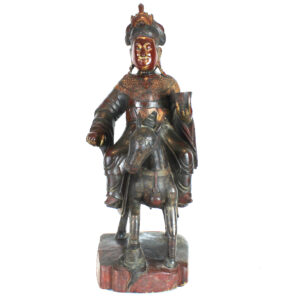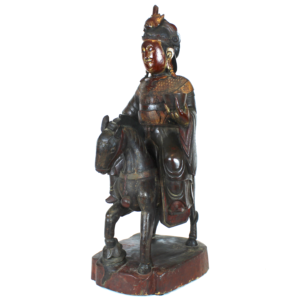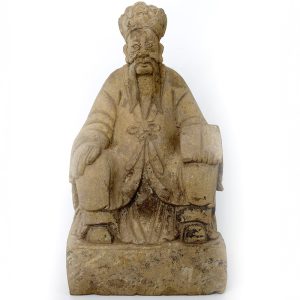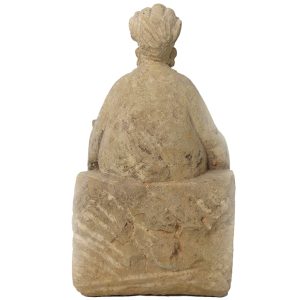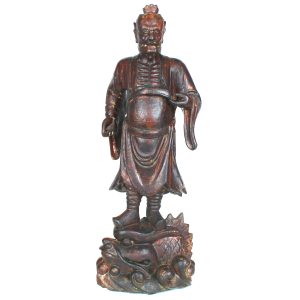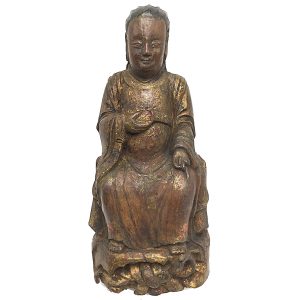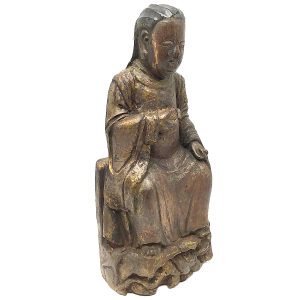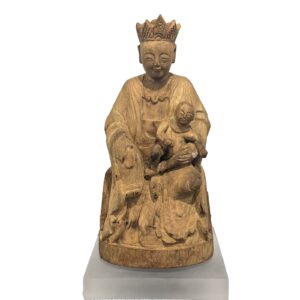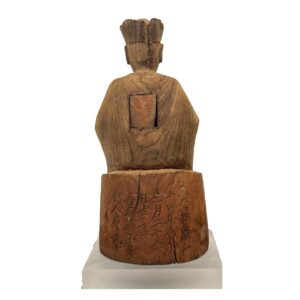Showing 13–24 of 26 results
-
Sale!


$3,750.00 Original price was: $3,750.00.$2,900.00Current price is: $2,900.00.
H: 22″ W: 8.75″ D: 10″ | CALL 213-568-3030 OR EMAIL [email protected] FOR SHIPPING.
Wearing a magnificent headdress with her iconic phoenix this rare image of the Taoist Queen Mother holds a cup with the elixir of immortality which grants eternal life. She sits on an regal horse with a bell hanging on his chest. In the Taoist tradition horses symbolize man’s harmony with and the elegance of nature.
-


$7,300.00
H: 28.25 W: 12.75” D: 9.75” | CALL 213-568-3030 OR EMAIL [email protected] FOR SHIPPING COST
Although they are Buddhist images, Lohans are portrayed as a real person with very individual, distinctive, and un-idealized features. His benevolent youthful sweetly smiling face with downcast eyes is an image of compassion, wisdom and peace.This exceptional, beautifully crafted rare 17-18th century Ming/Qing large Lohan is from the same Buddhist location as the foreign-born heavy bearded Lohan Bodhidharma, and the same artist may have carved both. We recommend keeping them as a pair to display together.
-


$725.00
H: 8” W: 5” D4” | FREE SHIPPING!
This antique stone Tudi Gong statue was finely crafted by a local provincial artisan and reflects many traditional characteristics of this beloved lower status deity: a benevolent face, voluminous rotund belly, slouched shoulders, and holding taels to bestow wealth and fortune and maybe assurances to rural common folk. In his past he rested happily on an outdoor shrine, and would be very happy to continue doing so in a home garden to bring prosperity and an aura of past times to a new family.
-


$795.00
Initially linked to the Big Dipper in Chinese mythology, Wen Chang is worshipped in the 3rd and 8th months as the God of several spheres: Literature, Books and Writing, Education, Learning and Examinations and is the patron saint of scholars. As one of the revered Taoist-deities, hero and one of the house-gods closely associated with…
-


$525.00
The Queen Mother of the West (Xiwangmu) is the most significant of the female Taoist deities and is viewed as having magical powers to controls life, death, creation and destruction and determines the lifespan of every living being. She lives with her husband the Jade Emperor in Kunlun Mountain where she attends her famous garden…
-


$995.00
The Kitchen God (Zao Shen) was and still is among the most important Chinese house gods. Traditionally every family had its own Kitchen God with or without his wife above the stove to reflect his and its central position in the family’s life. The Kitchen God is both a syncretic and a tutelary deity embraced…
-


$575.00
Zhenwu (aka Xuanwu, Wuandi and Zhenwudadi) is one of the most revered Chinese Taoist figures, venerated for his ability to heal as well as to protect his country and the emperor. There are various depictions of his attire, but here he wears a plain black robe with an official’s belt which he holds in his…
-
Sale!


$595.00 Original price was: $595.00.$395.00Current price is: $395.00.
H: 12″ W:5.6 ” D:4″ | FREE SHIPPING WITHIN CONTINENTAL U.S.!
Zhenwu, the True Warrior, Perfected Warrior or Northern Emperor was one of the most popular TaoistDeities in the Ming and Qing dynasties known as protector of the state and the imperial family. His feet here rest on a pedestal over a turtle with a lifted head and a snake curled around his shell. Among the many interpretations this represent beings over whom he presided including both celestial officers under his command, [and] former demons that were conquered by him. This is a fascinating carving symbolizes trusted strength. and power.
-


$295.00
While major deities such as Guandi were officially sanctioned by government and religious authorities, many popular deities and historic figures were integrated into Popular Religion beliefs where they were assimilated and greatly modified with local traditions and iconographic depictions such as this. We assume this is Guandi, one of the most revered Chinese deities based…
-


$785.00
These carvings of the Taoist-Deities Tudi Gong and his wife Tudi Po are from rural Southern China where they were frequently depicted together as house-gods on a home altar or local temple for farmers to pray to for abundant harvests and success in selling their products. Although Tudi Gong is a low ranking deity, he…
-
Sale!


$625.00 Original price was: $625.00.$375.00Current price is: $375.00.
H: 8.25″ W: 3.125″ D: 2.25″ | FREE SHIPPING!
This Kitchen God and his Wife is posed as streamlined virtual mirror-images and fashioned with a general quality relying on paint rather than deep carving for details. They sit on backless chairs on a plinth, with simplified gold officials’ robes with long color sashes, and well-carved black and gilt head gear. The wife’s face is smooth, generalized and the male face has a more deeply carved surface and painted highlights.
-
Sale!


$1,350.00 Original price was: $1,350.00.$1,100.00Current price is: $1,100.00.
H: 11” W: 5.75” D: 5.125” | FREE SHIPPING WITHIN CONTINENTAL U.S.!
This very rare and fine 16th century home shrine image displays the benign and compassionate countenance of Songzi Guanyin the “Bestower of Children.” With round face and joyful half-closed and eyes, she looks lovingly at the child whose arm is draped over hers.and leans slightly forward, wearing a 5- lobed crown centered with a camellia flower a Chinese symbol of young sons and daughters. The inscription on the back dates the piece to 1521-1567
End of content
End of content

